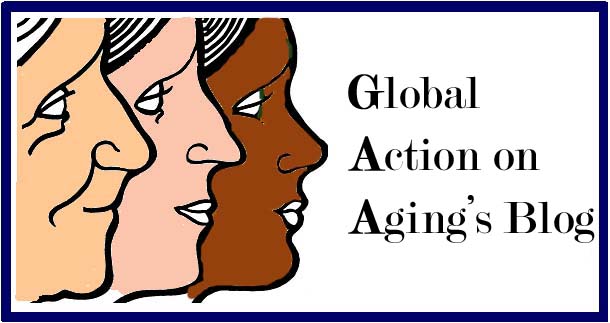Dear GAA Friend,
Are you an older woman who has considered having unprotected sex? If so, prepare now to protect yourself from infection with HIV.
Jane Fowler, Director
of the HIV Wisdom for Older Women program in the US, has put together important research on Older Women’s
vulnerability to HIV. Study her life-saving information carefully:
Facts Nearly 10 percent (9.5) of AIDS cases
in the US.female population are said to be in women older than age 50; and,
numbers of cases are expected to increase, as women of all ages survive longer
due to improved drug therapy and other treatment advances.
In the last decade, AIDS cases in
women over 50 were reported to have tripled, while heterosexual transmission
rates in this age group may have increased as much as 106 percent. But, because
not all US states report HIV infections, it is impossible to know how many
older American women are HIV-infected, but not diagnosed with AIDS.
"Older women," according
to UNAIDS, "appear to have higher incidence than older men, and during a
recent 5-year period, the number of new cases in this group increased by 40
percent. More than half of the infected over 50 are of African-American and
Hispanic origin, indicating greater risks among minority groups."
Older women of color have higher
rates of both HIV infections and diagnosed cases of AIDS.
While all older individuals with
HIV infection or AIDS usually are invisible, isolated and ignored, this is
particularly true of women, who are often unable to disclose their HIV status
even to family and friends and, certainly, not their community.
Despite myths and stereotypes, many
senior women are sexually active, and, some are drug users; therefore, their
behaviors can put them at risk for HIV infection.
Health care and service
providers---and older women, themselves---do not realize that they are at the
same risk as other age populations; professionals often are reluctant to
discuss or question matters of sexuality with their aging patients/clients.
Most women
are first diagnosed with HIV at a late stage of infection, and often become ill
with AIDS-related complications and die sooner than their younger counterparts;
these deaths can be attributed to original misdiagnoses and immune systems that
naturally weaken with age.
HIV/AIDS educational campaigns and
programs are not targeted at/to older individuals.
Special Considerations
Rates of HIV infection (not AIDS)
in all seniors, including women, are especially difficult to determine because
older people are not routinely tested.
Older people, especially women,
with HIV/AIDS face a double stigma: ageism and infection with a sexually or drug-injecting
transmitted disease; in addition, they are sensitive to a cultural attitude
that assumes: "Elderly people have lived their lives -- so what if they
die from AIDS?"
Seniors of both sexes are unlikely
to consistently use condoms during sex because of a generational mindset and
unfamiliarity with HIV/STD prevention methods.
For older women, there are special
considerations: after menopause, condom use for birth control becomes
unimportant, and normal aging changes such as a decrease in vaginal lubrication
and thinning vaginal walls can put them at higher risk during unprotected
sexual intercourse.
As HIV symptoms often are similar
to those associated with aging (fatigue, weight loss, dementia, skin rashes,
swollen lymph nodes), misdiagnosis is frequent in older women/people who are,
in fact, infected.
Women and older males may confront
social and professional bias regarding the allocation of limited health care
services and resources available to the AIDS community (i.e., "why waste
money on the elderly?")
Because the aging process itself
lowers energy levels and results in restrictions in social routines which can
cause emotional/psychological problems, the older woman/adult additionally
infected with HIV may feel another "loss" and endure more severe
depression.
Senior women often are less likely
to find support and comfort among family and friends, and because they are
traditionally not comfortable in support groups, they may be less inclined to
join them, citing lack of shared experiences concerning different issues.
Due to the general lack of
awareness of HIV/AIDS in older adults -- in particular, women -- this segment
of the population, for the most part, has been omitted from research, clinical
drug trials, educational prevention programs and intervention efforts.
Necessary Actions
Specific programs must be
implemented for older adults, especially women, who need to be informed about
the transmission and prevention of HIV.
Outreach should include workshops
and trainings devoted to basic HIV/AIDS information, "safe" sexual
and drug-using practices, testing, negotiation skills -- all in relationship to
aging.
More research is needed to study
seniors' sexual and drug-using behaviors and to determine HIV disease
progression and treatments in the over-50 population.
Health care and service providers
on all levels should be educated on HIV risk behaviors and symptoms of HIV
infection; they need to conduct thorough sex and drug-use risk assessments with
their older clients/patients.
Programs aimed at reaching health
care and service providers should cover misdiagnoses, testing technologies,
treatments, support groups, case management and the importance of being
actively involved in the health and well-being of their older clients/patients.
Successful media and social
marketing campaigns can raise awareness of HIV/AIDS in older people and
reinforce the need for educational programs, while promoting respect and
validation for the elderly as a group.
Jane P. Fowler compiled much of this tip sheet, based
primarily on personal perspectives and experiences of consumers and
professionals, while she was co-chairperson of the National Association on HIV
Over Fifty. Now director of the national HIV Wisdom for Older Women program,
she can be reached at: jane@hivwisdom.org.
Our thanks to Jane P. Fowler for her important research benefitting all older women.
Susanne Paul for Global Action on Aging


No comments:
Post a Comment